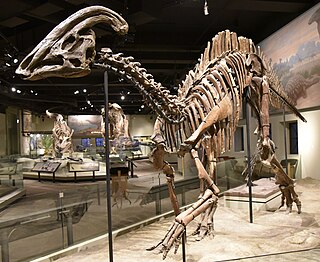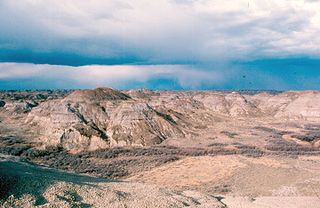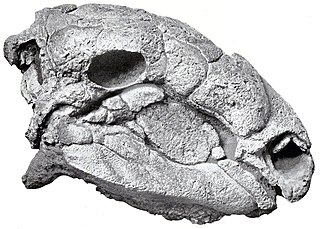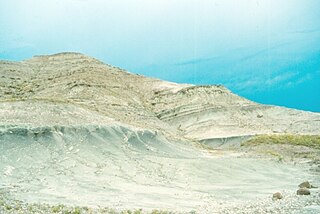
Biostratigraphy is the branch of stratigraphy which focuses on correlating and assigning relative ages of rock strata by using the fossil assemblages contained within them. The primary objective of biostratigraphy is correlation, demonstrating that a particular horizon in one geological section represents the same period of time as another horizon at a different section. Fossils within these strata are useful because sediments of the same age can look completely different, due to local variations in the sedimentary environment. For example, one section might have been made up of clays and marls, while another has more chalky limestones. However, if the fossil species recorded are similar, the two sediments are likely to have been laid down around the same time. Ideally these fossils are used to help identify biozones, as they make up the basic biostratigraphy units, and define geological time periods based upon the fossil species found within each section.

Hadrosaurids, or duck-billed dinosaurs, are members of the ornithischian family Hadrosauridae. This group is known as the duck-billed dinosaurs for the flat duck-bill appearance of the bones in their snouts. The ornithopod family, which includes genera such as Edmontosaurus and Parasaurolophus, was a common group of herbivores during the Late Cretaceous Period. Hadrosaurids are descendants of the Late Jurassic/Early Cretaceous iguanodontian dinosaurs and had a similar body layout. Hadrosaurs were among the most dominant herbivores during the Late Cretaceous in Asia and North America, and during the close of the Cretaceous several lineages dispersed into Europe, Africa, and South America.

Maiasaura is a large herbivorous saurolophine hadrosaurid ("duck-billed") dinosaur genus that lived in the area currently covered by the state of Montana and the province of Alberta, Canada, in the Upper Cretaceous Period, about 76.7 million years ago. Maiasaura peeblesorum is the state fossil of Montana.

Parasaurolophus is a genus of hadrosaurid "duck-billed" dinosaur that lived in what is now western North America and possibly Asia during the Late Cretaceous period, about 76.9–73.5 million years ago. It was a large herbivore that could reach over 9 metres (30 ft) long and weigh over 5 metric tons, and were able to move as a biped and a quadruped. Three species are universally recognized: P. walkeri, P. tubicen, and the short-crested P. cyrtocristatus. Additionally, a fourth species, P. jiayinensis, has been proposed, although it is more commonly placed in the separate genus Charonosaurus. Remains are known from Alberta, New Mexico, and Utah, as well as possibly Heilongjiang if Charonosaurus is in fact part of the genus. The genus was first described in 1922 by William Parks from a skull and partial skeleton found in Alberta.

Hypacrosaurus was a genus of duckbill dinosaur similar in appearance to Corythosaurus. Like Corythosaurus, it had a tall, hollow rounded crest, although not as large and straight. It is known from the remains of two species that spanned 75 to 67 million years ago, in the Late Cretaceous of Alberta, Canada, and Montana, United States, and is the latest hollow-crested duckbill known from good remains in North America. It was an obscure genus until the discovery in the 1990s of nests, eggs, and hatchlings belonging to H. stebingeri.

Echinodon is a genus of heterodontosaurid dinosaur that lived during the earliest Cretaceous of southern England and possibly western France in the Berriasian epoch. The first specimens were jaw bones named Echinodon becklesii by Sir Richard Owen in 1861, and since their original description only additional teeth have been discovered. The specific name honours collector Samuel Beckles who discovered the material of Echinodon and many other taxa from across England, while the genus name translates as "prickly tooth" in reference to the dental anatomy of the taxon.

Scolosaurus is an extinct genus of ankylosaurid dinosaurs within the subfamily Ankylosaurinae. It is known from the lower levels of the Dinosaur Park Formation and upper levels of the Oldman Formation in the Late Cretaceous of Alberta, Canada. It contains two species, S. cutleri and S. thronus. The type species, S. cutleri, measured up to 5.6 metres (18 ft) in length and 2.2 metric tons in body mass.

The Dinosaur Park Formation is the uppermost member of the Belly River Group, a major geologic unit in southern Alberta. It was deposited during the Campanian stage of the Late Cretaceous, between about 76.5 and 74.4 million years ago. It was deposited in alluvial and coastal plain environments, and it is bounded by the nonmarine Oldman Formation below it and the marine Bearpaw Formation above it.
The Oldman Formation is a stratigraphic unit of Late Cretaceous age that underlies much of southern Alberta, Canada. It consists primarily of sandstones that were deposited in fluvial channel and floodplain environments. It was named for exposures along the Oldman River between its confluence with the St. Mary River and the city of Lethbridge, and it is known primarily for its dinosaur remains and other fossils.

Panoplosaurus is a genus of armoured dinosaur from the Late Cretaceous of Alberta, Canada. Few specimens of the genus are known, all from the middle Campanian of the Dinosaur Park Formation, roughly 76 to 75 million years ago. It was first discovered in 1917, and named in 1919 by Lawrence Lambe, named for its extensive armour, meaning "well-armoured lizard". Panoplosaurus has at times been considered the proper name for material otherwise referred to as Edmontonia, complicating its phylogenetic and ecological interpretations, at one point being considered to have existed across Alberta, New Mexico and Texas, with specimens in institutions from Canada and the United States. The skull and skeleton of Panoplosaurus are similar to its relatives, but have a few significant differences, such as the lumpy form of the skull osteoderms, a completely fused shoulder blade, and regularly shaped plates on its neck and body lacking prominent spines. It was a quadrupedal animal, roughly 5 m (16 ft) long and 1,600 kg (3,500 lb) in weight. The skull has a short snout, with a very domed surface, and bony plates directly covering the cheek. The neck had circular groups of plates arranged around the top surface, both the forelimb and hindlimb were about the same length, and the hand may have only included three fingers. Almost the entire surface of the body was covered in plates, osteoderms and scutes of varying sizes, ranging from large elements along the skull and neck, to smaller, round bones underneath the chin and body, to small ossicles that filled in the spaces between other, larger osteoderms.

The Two Medicine Formation is a geological formation, or rock body, in northwestern Montana and southern Alberta that was deposited between 83.5 ± 0.7 Ma and 70.6 ± 3.4 Ma, during Campanian time. It crops out to the east of the Rocky Mountain Overthrust Belt, and the western portion of this formation is folded and faulted while the eastern part, which thins out into the Sweetgrass Arch, is mostly undeformed plains. Below the formation are the nearshore deposits of the Virgelle Sandstone, and above it is the marine Bearpaw Shale. Throughout the Campanian, the Two Medicine Formation was deposited between the western shoreline of the Late Cretaceous Interior Seaway and the eastward advancing margin of the Cordilleran Overthrust Belt. The Two Medicine Formation is mostly sandstone, deposited by rivers and deltas.
The Chañares Formation is a Carnian-age geologic formation of the Ischigualasto-Villa Unión Basin, located in La Rioja Province, Argentina. It is characterized by drab-colored fine-grained volcaniclastic claystones, siltstones, and sandstones which were deposited in a fluvial to lacustrine environment. The formation is most prominently exposed within Talampaya National Park, a UNESCO World Heritage Site within La Rioja Province.
The Horsethief Sandstone is a Mesozoic geologic formation in Montana. Dinosaur remains are among the fossils that have been recovered from the formation, although none have yet been referred to a specific genus. The southern part of the Two Medicine Formation grades into the brackish water siltstone/sandstone series that compose the Horsethief Formation. To the north the Horsethief Sandstone is equivalent to the Blood Reserve Formation of Alberta, Canada.
Continuoolithus is an oogenus of dinosaur egg found in the late Cretaceous of North America. It is most commonly known from the late Campanian of Alberta and Montana, but specimens have also been found dating to the older Santonian and the younger Maastrichtian. It was laid by an unknown type of theropod. These small eggs are similar to the eggs of oviraptorid dinosaurs, but have a distinctive type of ornamentation.
Dinosaur paleobiogeography is the study of dinosaur geographic distribution, based on evidence in the fossil record.

Acristavus is a genus of saurolophine dinosaur. Fossils have been found from the Campanian Two Medicine Formation in Montana and Wahweap Formation in Utah, United States. The type species A. gagslarsoni was named in 2011. Unlike nearly all hadrosaurids except Edmontosaurus, Acristavus lacked ornamentation on its skull. The discovery of Acristavus is paleontologically significant because it supports the position that the ancestor of all hadrosaurids did not possess cranial ornamentation, and that ornamentation was an adaptation that later arose interdependently in the subfamilies Saurolophinae and Lambeosaurinae. It is closely related to Brachylophosaurus and Maiasaura, and was assigned to a new clade called Brachylophosaurini.

Adynomosaurus is a genus of lambeosaurine dinosaur from the Late Cretaceous of what is now Catalonia, Spain. First discovered in 2012, it was named in 2019 with the type and only species being Adynomosaurus arcanus. It is only known from scant material, but is distinguished from other hadrosaurs by its weakly developed shoulder blade which would have had underdeveloped musculature, which lends it its scientific name, partially from the Greek word for "weak". Its exact relationships with other hadrosaurs remain unresolved, with it not consistently being recovered as a relative of any other specific genera, though some studies have allied it with Tsintaosaurini or even found it outside of Hadrosauridae. It would have lived as part of a diverse coastal estuary ecosystem, made up of meandering rivers and mud flats. The discovery of Adynomosaurus adds to the very incomplete fossil record of hadrosaurid dinosaurs in the Late Cretaceous of Europe, and it fits into a picture of major ecological turnover that was occurring during the Maastrichtian stage in the region.

Galleonosaurus is a genus of basal ornithopod dinosaur from the Wonthaggi Formation of the Gippsland region of Victoria, Australia. The type and only species is Galleonosaurus dorisae.

Paraxenisaurus is an extinct genus of ornithomimosaurian theropod from the Late Cretaceous Cerro del Pueblo Formation of Coahuila in Mexico. The genus contains a single species, P. normalensis, which is known from a few bones of tail, hips, hands, and feet. The specific epithet was given in honor of the Benemérita Normal School of Coahuila, a teacher training institution, where the fossils were reposited. It is a member of the family Deinocheiridae and is the only member of that clade known from Laramidia.
Land vertebrate faunachrons (LVFs) are biochronological units used to correlate and date terrestrial sediments and fossils based on their tetrapod faunas. First formulated on a global scale by Spencer G. Lucas in 1998, LVFs are primarily used within the Triassic Period, though Lucas later designated LVFs for other periods as well. Eight worldwide LVFs are defined for the Triassic. The first two earliest Triassic LVFs, the Lootsbergian and Nonesian, are based on South African synapsids and faunal assemblage zones estimated to correspond to the Early Triassic. These are followed by the Perovkan and Berdyankian, based on temnospondyl amphibians and Russian assemblages estimated to be from the Middle Triassic. The youngest four Triassic LVFs, the Otischalkian, Adamanian, Revueltian, and Apachean, are based on aetosaur and phytosaur reptiles common in the Late Triassic of the southwestern United States.















